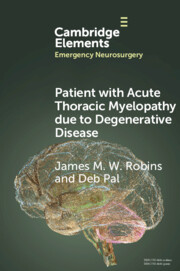Refine search
Actions for selected content:
70 results
Nationwide Preparedness Exercise Revealed Variation in Readiness for Outbreak Investigation in Environmental Health Units in Finland, 2020
-
- Journal:
- Disaster Medicine and Public Health Preparedness / Volume 19 / 2025
- Published online by Cambridge University Press:
- 04 August 2025, e215
-
- Article
-
- You have access
- Open access
- HTML
- Export citation
3 - Conflicts of Interest
-
- Book:
- Spinning the World
- Published online:
- 03 July 2025
- Print publication:
- 24 July 2025, pp 62-81
-
- Chapter
- Export citation
8 - Selling the World to America
-
- Book:
- Spinning the World
- Published online:
- 03 July 2025
- Print publication:
- 24 July 2025, pp 174-208
-
- Chapter
- Export citation

Patient with Acute Thoracic Myelopathy due to Degenerative Disease
-
- Published online:
- 20 May 2025
- Print publication:
- 19 June 2025
-
- Element
- Export citation
Chapter 15 - Investigation of Recurrent Pregnancy Loss
-
-
- Book:
- Early Pregnancy
- Published online:
- 16 April 2025
- Print publication:
- 08 May 2025, pp 153-161
-
- Chapter
- Export citation
9 - The Duty to Investigate and Prosecute Torture and Ill-Treatment in Peacetime
-
- Book:
- The Prohibition of Torture and Ill-Treatment under International Law
- Published online:
- 17 April 2025
- Print publication:
- 24 April 2025, pp 215-236
-
- Chapter
- Export citation
10 - The Duty to Punish Genocide
-
- Book:
- Genocide in International Law
- Published online:
- 14 March 2025
- Print publication:
- 03 April 2025, pp 463-537
-
- Chapter
- Export citation
Investigating Heritage and Climate Change in the Coastal and Maritime Environments of Wales and Ireland: A Guide to the CHERISH Toolkit
-
- Journal:
- Advances in Archaeological Practice / Volume 12 / Issue 3 / August 2024
- Published online by Cambridge University Press:
- 15 October 2024, pp. 219-232
-
- Article
-
- You have access
- HTML
- Export citation

Silencing Citizens
- How Criminal Groups Create Vacuums of Justice
-
- Published online:
- 04 September 2024
- Print publication:
- 23 May 2024
17 - International Criminal Procedure
- from Part V - International Criminal Procedure and Sentencing
-
- Book:
- An Introduction to International Criminal Law and Procedure
- Published online:
- 07 November 2024
- Print publication:
- 18 July 2024, pp 387-425
-
- Chapter
- Export citation
Conclusion
-
- Book:
- Silencing Citizens
- Published online:
- 04 September 2024
- Print publication:
- 23 May 2024, pp 259-276
-
- Chapter
- Export citation
2 - Research Design and Definitions
- from Part I - Why Police–Citizen Cooperation Matters
-
- Book:
- Silencing Citizens
- Published online:
- 04 September 2024
- Print publication:
- 23 May 2024, pp 61-86
-
- Chapter
- Export citation
8 - Evidence
- from Part III - Interventions for Promoting Cooperation
-
- Book:
- Silencing Citizens
- Published online:
- 04 September 2024
- Print publication:
- 23 May 2024, pp 239-258
-
- Chapter
- Export citation
7 - Evidence
- from Part III - Interventions for Promoting Cooperation
-
- Book:
- Silencing Citizens
- Published online:
- 04 September 2024
- Print publication:
- 23 May 2024, pp 217-238
-
- Chapter
- Export citation
6 - Theory
- from Part III - Interventions for Promoting Cooperation
-
- Book:
- Silencing Citizens
- Published online:
- 04 September 2024
- Print publication:
- 23 May 2024, pp 177-216
-
- Chapter
- Export citation
1 - Study Motivation
- from Part I - Why Police–Citizen Cooperation Matters
-
- Book:
- Silencing Citizens
- Published online:
- 04 September 2024
- Print publication:
- 23 May 2024, pp 27-60
-
- Chapter
- Export citation
Introduction
-
- Book:
- Silencing Citizens
- Published online:
- 04 September 2024
- Print publication:
- 23 May 2024, pp 1-24
-
- Chapter
- Export citation
Chapter 6 - Inquiry science for young children
- from Part 2 - How can I enhance children’s learning of science?
-
-
- Book:
- Science in Early Childhood
- Published online:
- 13 December 2023
- Print publication:
- 10 January 2024, pp 89-103
-
- Chapter
- Export citation

God and the Problem of Evidential Ambiguity
-
- Published online:
- 20 December 2023
- Print publication:
- 09 May 2024
-
- Element
- Export citation
Chapter 1 - Teaching mathematics today with tomorrow in mind
-
- Book:
- Primary Mathematics
- Published online:
- 01 September 2023
- Print publication:
- 07 September 2023, pp 1-11
-
- Chapter
- Export citation
